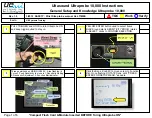
1: General Description
2
U3000/U4000 User Manual
(Issue 2.0)
Both the U3000 and U4000 have ‘A’ and ‘B’ model options, which refer to the transducer type provided. Thus
a U3000A will be supplied with type ‘A’ transducers which are designed to work with pipe diameters between
13mm - 115mm; whereas a U4000B will be supplied with type ‘B’ transducers which are designed to work
with pipe diameters between 50mm - 2000mm. Both sets of transducers use a common mounting system for
pipe attachment. Throughout this manual any reference to ’U3000/U4000’ applies to both U3000A/B and
U4000A/B model variants unless otherwise stated.
Note: Type ‘A’ and ‘B’ probe sets are fully interchangeable and the alternative probe kit can be purchased
separately if required to extend the usable range of the instrument.
1.2
Principles of Operation
Figure 1.1 Operating modes
When ultrasound is transmitted through a liquid the speed at which the sound travels through the liquid is
accelerated slightly if it is transmitted in the same direction as the liquid flow and decelerated slightly if
Fluid flow
Fluid flow
Fluid flow
Fluid flow
Fluid flow
U
U
U
U
D
D
D
D
Separation
Distance
Separation
Distance
Separation
Distance
Separation
Distance
Reflex mode
Reflex mode (double bounce)
Reflex mode (triple bounce)
Diagonal mode
This is the mode most commonly used.
The two transducers (U & D) are attached
to the pipe in line with each other and the
signals passing between them are reflected
by the opposite pipe wall.
The separation distance is calculated by
the instrument in response to entered data
concerning the pipe and fluid characteristics.
In this mode the separation distance is
calculated to give a double bounce. This is
most likely to occur if the pipe diameter is
so small that the calculated reflex mode
separation distance would be impractical
for the transducers in use.
This illustration goes one step further to show
a triple bounce situation. This would normally
apply when working with very small pipes
relative to the transducer range in use.
This mode might be selected by the
instrument where relatively large pipes are
concerned. In this mode the transducers are
located on opposite sides of the pipe but the
separation distance is still critical in order
for the signals to be received correctly.
This mode might be used with the standard
‘A’ & ‘B’ transducer sets but for really large
pipe installation the optional transducer set ‘D’
might be recommended.
Upstream
transducer







































